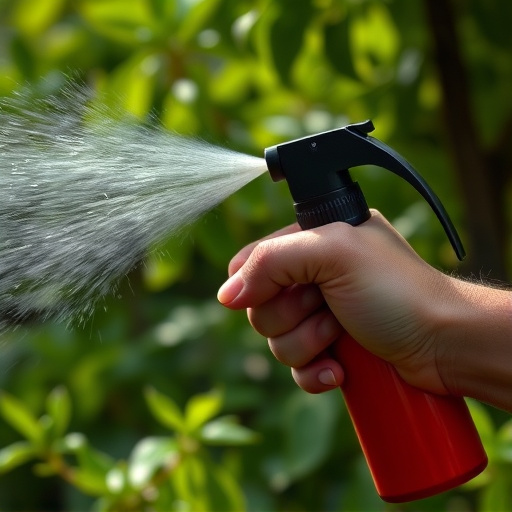Capsaicin-based pepper spray, a powerful defense tool, induces physiological responses in assailants. Effective use involves aiming for sensitive areas, maintaining safe distances, and proper application techniques. Training tips emphasize understanding device mechanics, practicing under varied conditions, simulating dangerous scenarios, and de-escalation tactics. Legal regulations vary globally, but responsible use prioritizes safety, distance, and ethical considerations during deployment. Pepper spray defense training enhances personal safety when combined with self-defense skills and regular practice.
“Discover the power of nature’s defense mechanism with our in-depth guide to capsicum-based personal protection. From understanding the science behind pepper spray to mastering deployment techniques, this article equips you with all you need to know for effective self-defense. Learn about key features to look for in a device, legal considerations, and real-life scenarios where pepper spray can be a game-changer. Boost your safety and gain valuable pepper spray defense training tips today.”
- Understanding Capsaicin: The Science Behind Pepper Spray
- Choosing Your Personal Defense Device: Features to Consider
- Effective Training Techniques for Optimal Protection
- Legal Implications and Usage Guidelines
- Real-Life Scenarios: When and How to Deploy Pepper Spray
Understanding Capsaicin: The Science Behind Pepper Spray
Capsaicin, the active ingredient in pepper spray, is a natural compound derived from chili peppers. Its potent irritant properties make it an effective personal protection tool. When exposed to capsaicin, the body experiences a cascade of physiological responses triggered by the binding of the compound to specific nerve receptors. This reaction leads to symptoms like teary eyes, difficulty breathing, and intense pain, temporarily disorienting and incapacitating the assailant.
Pepper spray defense training tips emphasize understanding this science to maximize its effectiveness in real-life situations. Knowing how capsaicin interacts with the nervous system allows individuals to deploy it strategically, aiming for vulnerable areas like the eyes and face. Proper training ensures users can apply the spray accurately while maintaining safe distances, minimizing collateral damage and maximizing their own safety during self-defense scenarios.
Choosing Your Personal Defense Device: Features to Consider
When choosing a personal protection device, one of the most effective options is a pepper spray. In addition to its immediate impact in deterring potential attackers, it’s crucial to select a product with specific features for optimal defense. Look for high-quality pepper spray that offers a powerful yet controlled stream, ensuring you can accurately target and disable an assailant from a safe distance.
Consider the size and ease of use; a compact design with a convenient spray mechanism is ideal for carrying discreetly in your pocket or bag. Also, check the range and duration of its effects, as these factors play a significant role in your safety during an encounter. Incorporating defense training tips, such as learning proper application techniques, into your decision-making process will further enhance the effectiveness of your chosen pepper spray personal protection device.
Effective Training Techniques for Optimal Protection
Effective training is key to maximizing the protection offered by a capsaicin-based personal protection device, like pepper spray. When learning to use such a tool, it’s crucial to focus on both practice and understanding. Start with familiarizing yourself with the device’s mechanics: how it dispenses the spray, its range, and safety features. Practice aiming accurately under various conditions—in low light, at different distances, and while moving. This ensures you can deploy the spray effectively when needed.
Incorporate Pepper Spray Defense Training Tips into your practice sessions. Simulate real-world scenarios to build instinctive responses. Train with a trusted partner who can provide feedback on your technique. Remember, consistent and realistic training is vital to developing muscle memory for crucial movements. By combining knowledge with hands-on experience, you’ll be better prepared to handle potentially dangerous situations safely and confidently.
Legal Implications and Usage Guidelines
The legal implications surrounding capsaicin-based personal protection devices, often referred to as pepper spray, vary significantly across jurisdictions. What is widely accepted is that these devices are legal when used for self-defense and law enforcement purposes, provided they adhere to specific guidelines. In many regions, pepper spray must meet certain criteria, such as having a controlled release mechanism and limited active ingredients, to ensure its use is proportionate and safe.
When it comes to usage guidelines, Pepper Spray Defense Training Tips are essential for responsible users. This includes learning the appropriate distance and angle for application, understanding de-escalation techniques, and being aware of potential contraindications (e.g., individuals with respiratory conditions). Proper training can ensure that pepper spray is deployed effectively and ethically, minimizing harm while maximizing its protective benefits.
Real-Life Scenarios: When and How to Deploy Pepper Spray
In real-life scenarios, pepper spray can be a powerful tool for personal protection. It’s crucial to understand when and how to deploy it effectively. Pepper spray defense training tips suggest that the best time to use pepper spray is during an attack or perceived threat, when the aggressor is close enough to cause harm but not yet in physical contact. This allows you to disrupt their approach and create a momentary escape route.
When deploying pepper spray, aim for the eyes and face of the attacker. The spray can temporarily blind and disorient them, providing valuable time for you to retreat or call for help. It’s important to remember that pepper spray is not a substitute for self-defense training; rather, it’s a tactical addition that can enhance your safety in high-risk situations. Regularly practicing with pepper spray and understanding its limitations will ensure you’re prepared when facing dangerous scenarios.
A capsaicin-based personal protection device, like pepper spray, can be a powerful tool for self-defense. By understanding the science behind its active ingredient, choosing the right device with key features, and receiving effective training, individuals can maximize their safety in potential threatening situations. It’s crucial to familiarize yourself with legal implications and guidelines, as well as practice deployment techniques in real-life scenarios to ensure optimal protection. Remember, proper preparation and knowledge are essential for confident and responsible self-defense using pepper spray defense training tips.
